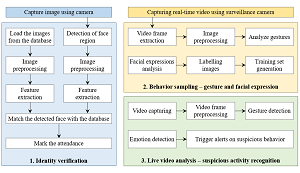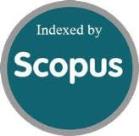Deep Learning-Based Smart Invigilation System for Enhanced Exam Integrity
DOI:
https://doi.org/10.46604/peti.2024.14105Keywords:
suspicious activity detection, exam integrity, deep learning, face and gesture recognition, emotion analysisAbstract
This study proposes a smart invigilation system to preserve exam integrity by detecting suspicious student behaviors using deep learning. The model consists of three phases, i.e., student identity verification using face recognition, behavioral sampling for model training utilizing gesture analysis and convolutional 3D networks for emotion analysis, and live video analysis of suspicious activities integrating gesture, emotional analysis, and face recognition. The model is evaluated using 4,000 training and 1,000 test images and identifies non-cheating activities with 99% accuracy and cheating activities with 97.6% accuracy. The proposed model outperforms other methods, achieving accuracies of 98.4% for identifying cheating behaviors and 99.2% for non-cheating behaviors, resulting in an overall accuracy of 98.8% and a low misclassification rate of 1.2%. While the system demonstrates high accuracy, challenges remain in scaling to larger classrooms due to increased computational demand and the need for additional hardware to ensure comprehensive monitoring.
References
S. Erduran, Y. El Masri, A. Cullinane, and Y. P. D. Ng, “Assessment of Practical Science in High Stakes Examinations: A Qualitative Analysis of High Performing English-Speaking Countries,” International Journal of Science Education, vol. 42, no. 9, pp. 1544-1567, 2020.
K. A. A. Gamage, R. G. G. R. Pradeep, and E. K. de Silva, “Rethinking Assessment: The Future of Examinations in Higher Education,” Sustainability, vol. 14, no. 6, article no. 3552, 2022.
M. A. Mulongo, “Effectiveness of University Examinations Management Strategies in Mitigating Examination Malpractices in Kenya,” Ph.D. dissertation, Karatina University, Kenya, 2020.
J. Nishchal, S. Reddy, and P. N. Navya, “Automated Cheating Detection in Exams Using Posture and Emotion Analysis,” IEEE International Conference on Electronics, Computing and Communication Technologies, pp. 1-6, 2020.
O. L. Holden, M. E. Norris, and V. A. Kuhlmeier, “Academic Integrity in Online Assessment: A Research Review,” Frontiers in Education, vol. 6, article no. 639814, 2021.
F. Kamalov, H. Sulieman, and D. Santandreu Calonge, “Machine Learning Based Approach to Exam Cheating Detection,” PLoS ONE, vol. 16, no. 8, article no. e0254340, 2021.
M. J. Hoque, M. R. Ahmed, M. J. Uddin, and M. M. A. Faisal, “Automation of Traditional Exam Invigilation Using CCTV and Bio-Metric,” International Journal of Advanced Computer Science and Applications, vol. 11, no. 6, pp. 392-399, 2020.
P. Alin, A. Arendt, and S. Gurell, “Addressing Cheating in Virtual Proctored Examinations: Toward a Framework of Relevant Mitigation Strategies,” Assessment & Evaluation in Higher Education, vol. 48, no. 3, pp. 262-275, 2023.
Y. Liu, J. Ren, J. Xu, X. Bai, R. Kaur, and F. Xia, “Multiple Instance Learning for Cheating Detection and Localization in Online Examinations,” IEEE Transactions on Cognitive and Developmental Systems, vol. 16, no. 4, pp. 1315-1326, 2024.
M. Asad, M. Abbas, A. Asim, A. Hafeez, M. M. Sadaf, A. U. Haq, et al., “Suspicious Activity Detection During Physical Exams,” unpublished.
P. Verma, N. Malhotra, R. Suri, and R. Kumar, “Automated Smart Artificial Intelligence-Based Proctoring System Using Deep Learning,” Soft Computing, vol. 28, no. 4, pp. 3479-3489, 2024.
J. Xue, W. Wu, and Q. Cheng, “Intelligent Invigilator System Based on Target Detection,” Multimedia Tools and Applications, vol. 82, no. 29, pp. 44673-44695, 2023.
J. A. Hernándeza, A. Ochoab, J. Muñozd, and G. Burlaka, “Detecting Cheats in Online Student Assessments Using Data Mining,” International Conference on Data Mining, pp. 204-210, 2006.
Y. Atoum, L. Chen, A. X. Liu, S. D. H. Hsu, and X. Liu, “Automated Online Exam Proctoring,” IEEE Transactions on Multimedia, vol. 19, no. 7, pp. 1609-1624, 2017.
L. C. O. Tiong and H. J. Lee, “E-Cheating Prevention Measures: Detection of Cheating at Online Examinations Using Deep Learning Approach -- A Case Study,” https://doi.org/10.48550/arXiv.2101.09841, 2021.
S. El Kohli, Y. Jannaj, M. Maanan, and H. Rhinane, “Deep Learning: New Approach for Detecting Scholar Exams Fraud,” The International Archives of the Photogrammetry, Remote Sensing and Spatial Information Sciences, vol. XLVI-4/W3-2021, pp. 103-107, 2022.
F. Mahmood, J. Arshad, M. T. Ben Othman, M. F. Hayat, N. Bhatti, M. H. Jaffery, et al., “Implementation of an Intelligent Exam Supervision System Using Deep Learning Algorithms,” Sensors, vol. 22, no. 17, article no. 6389, 2022.
M. D. Genemo, “Suspicious Activity Recognition for Monitoring Cheating in Exams,” Proceedings of the Indian National Science Academy, vol. 88, no. 1, pp. 1-10, 2022.
R. M. Al_airaji, I. A. Aljazaery, H. T. Alrikabi, and A. H. M. Alaidi, “Automated Cheating Detection Based on Video Surveillance in the Examination Classes,” International Journal of Interactive Mobile Technologies, vol. 16, no. 08, pp. 124-137, 2022.
R. K. Kadthim and Z. H. Ali, “Cheating Detection in Online Exams Using Machine Learning,” Journal Of AL-Turath University College, vol. 2, no. 35, pp. 35-41, 2023.
W. Alsabhan, “Student Cheating Detection in Higher Education by Implementing Machine Learning and LSTM Techniques,” Sensors, vol. 23, no. 8, article no. 4149, 2023.
T. Zhou and H. Jiao, “Exploration of the Stacking Ensemble Machine Learning Algorithm for Cheating Detection in Large-Scale Assessment,” Educational and Psychological Measurement, vol. 83, no. 4, pp. 831-854, 2023.
S. C. Chang and K. L. Chang, “Cheating Detection of Test Collusion: A Study on Machine Learning Techniques and Feature Representation,” Educational Measurement: Issues and Practice, vol. 42, no. 2, pp. 62-73, 2023.
S. Z. Ong, T. Connie, and M. K. O. Goh, “Cheating Detection for Online Examination Using Clustering Based Approach,” JOIV: International Journal on Informatics Visualization, vol. 7, no. 3-2, pp. 2075-2085, 2023.
F. Ozdamli, A. Aljarrah, D. Karagozlu, and M. Ababneh, “Facial Recognition System to Detect Student Emotions and Cheating in Distance Learning,” Sustainability, vol. 14, no. 20, article no. 13230, 2022.
A. L. Cîrneanu, D. Popescu, and D. Iordache, “New Trends in Emotion Recognition Using Image Analysis by Neural Networks, A Systematic Review,” Sensors, vol. 23, no. 16, article no. 7092, 2023.
S. Peng, H. Huang, W. Chen, L. Zhang, and W. Fang, “More Trainable Inception-ResNet for Face Recognition,” Neurocomputing, vol. 411, pp. 9-19, 2020.
A. Kumar, Z. J. Zhang, and H. Lyu, “Object Detection in Real Time Based on Improved Single Shot Multi-Box Detector Algorithm,” EURASIP Journal on Wireless Communications and Networking, vol. 2020, no. 1, article no. 204, 2020.
L. Ling, J. Tao, and G. Wu, “Research on Gesture Recognition Based on YOLOv5,” 33rd Chinese Control and Decision Conference, pp. 801-806, 2021.
E. S. Salama, R. A. El-Khoribi, M. E. Shoman, and M. A. W. Shalaby, “A 3D-Convolutional Neural Network Framework with Ensemble Learning Techniques for Multi-Modal Emotion Recognition,” Egyptian Informatics Journal, vol. 22, no. 2, pp. 167-176, 2021.

Published
How to Cite
Issue
Section
License
Copyright (c) 2025 Saravanan Arumugam

This work is licensed under a Creative Commons Attribution-NonCommercial 4.0 International License.
Submission of a manuscript implies: that the work described has not been published before that it is not under consideration for publication elsewhere; that if and when the manuscript is accepted for publication. Authors can retain copyright of their article with no restrictions. Also, author can post the final, peer-reviewed manuscript version (postprint) to any repository or website.

Since Oct. 01, 2015, PETI will publish new articles with Creative Commons Attribution Non-Commercial License, under The Creative Commons Attribution Non-Commercial 4.0 International (CC BY-NC 4.0) License.
The Creative Commons Attribution Non-Commercial (CC-BY-NC) License permits use, distribution and reproduction in any medium, provided the original work is properly cited and is not used for commercial purposes







